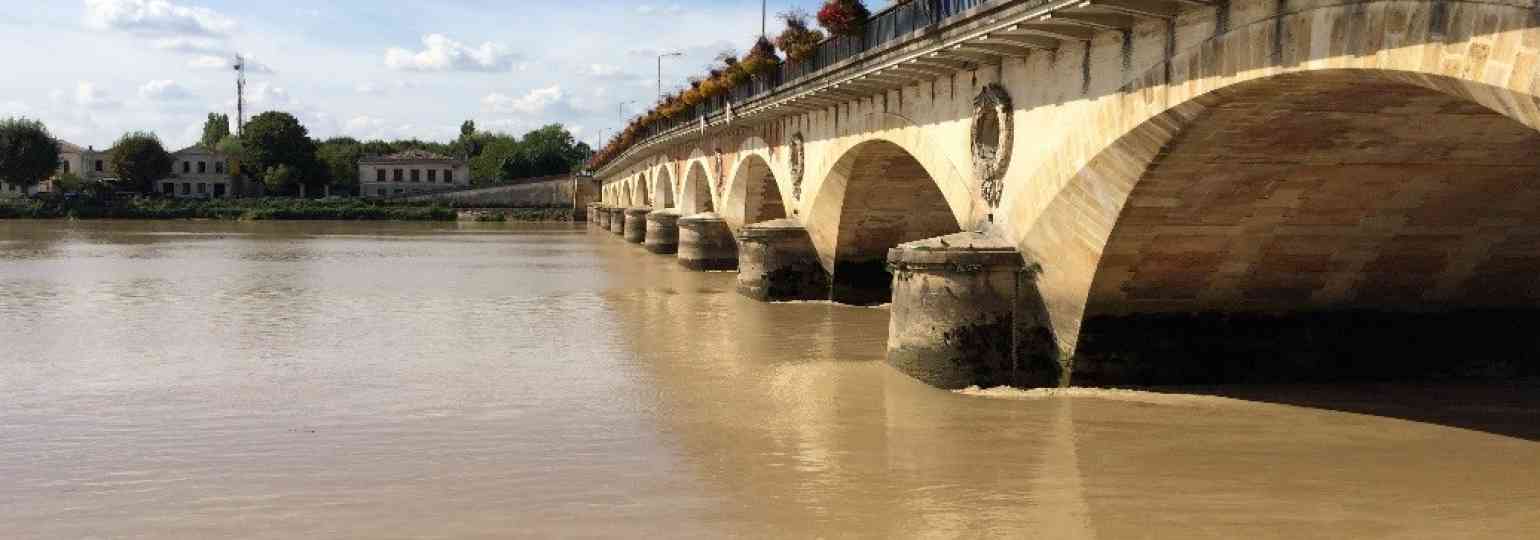
Restoration of the right-side abutment of the Stone Bridge in Libourne: How the teams from OSMOS Group succeeded in installing a comprehensive monitoring system in compliance with the architectural requirements of the work.
The Stone Bridge in Libourne was built in 1820 to create a road connection between Bordeaux and Saint-Emilion for the transport of wine. The structure is both an icon of the Gironde region and part of its heritage. The red bricks used to construct it were made in the greater Nouvelle-Aquitaine region and attest to the masonry expertise characteristic of the Gironde area.
The bridge was partially destroyed in the Second World War, and the damaged portion of it was reconstructed and reinforced with concrete. Since then, the structure has been particularly susceptible to continuous dynamic factors such as tidal changes, bridge traffic, and tree trunks swept down the Dordogne River during heavy rains. Over time a fissure has appeared on the structure, running from one side of the right abutment to the other and going through the intrados of the arch (interior side). This is due to a previous collapse occurring at this part of the structure.
The problem consisted of finding the causes for this compression and, if need be, eliminating them before restoring the dry arch and the abutment's facing, especially since there was doubt as to the nature and formation of this abutment's foundations. The expert assessment conducted by ARTELIA and JP LEVILLAIN, based on analysis of the archives and surveys, showed that the fracture appeared after the reconstruction of the arches following the war and that it was due to the inadvertent filling of gaps in the spandrels with concrete during the reconstruction work. In the absence of further pressure, the compressing factor should stabilize.
Therefore, the decision was made to repair the fracture with original materials, namely bricks from the town of Gironde-sur-Dropt. During the renovation of the bridge, which was carried out with the best industry practices, OSMOS Group was able to work together with the teams responsible for the construction work. It was also decided to incorporate a monitoring system installed inside the renovated portion in order to monitor various factors and confirm the assumptions made by the experts.
The monitoring system proposed by OSMOS is made up of Optical Strands with integrated temperature sensors. Using indentations designed for this purpose, the Strands are placed directly in the lime cement located behind the brick facing in order to respect the aesthetics of the heritage structure. Since the Stone Bridge in Libourne is located within an area where historic monuments are protected, it must meet certain architectural criteria. Therefore, OSMOS was able to adapt its monitoring system in order to comply with the requirements imposed on such a structure.
A sensor at the level of the water, a ground water measurement sensor, and a leveling sensor were also installed to complete the structure's monitoring. All of the sensors were then linked up with an OSMOS Expert Data Acquisition System that facilitates the storage and transmission of data through a 3G connection.
The age of the structure and the constant dynamic influences it is exposed to are sources of long-term strain that need to be assessed. The Stone Bridge in Libourne must therefore be subject to a comprehensive structural review, which is particularly interesting for OSMOS to observe. At the same time, the collaboration with the local teams in charge of its renovation made it possible to directly incorporate the Optical Strands necessary for monitoring the structure behind the masonry. Thus, the project is part of a heritage preservation initiative.
The objective of OSMOS Group's work on the Stone Bridge in Libourne is, above all, to provide unique and accurate information to the bridge's overseer so that he can have a greater understanding of the structure. For preventive purposes, the continuous monitoring also guarantees the long-term stability of the structure following the construction work.
